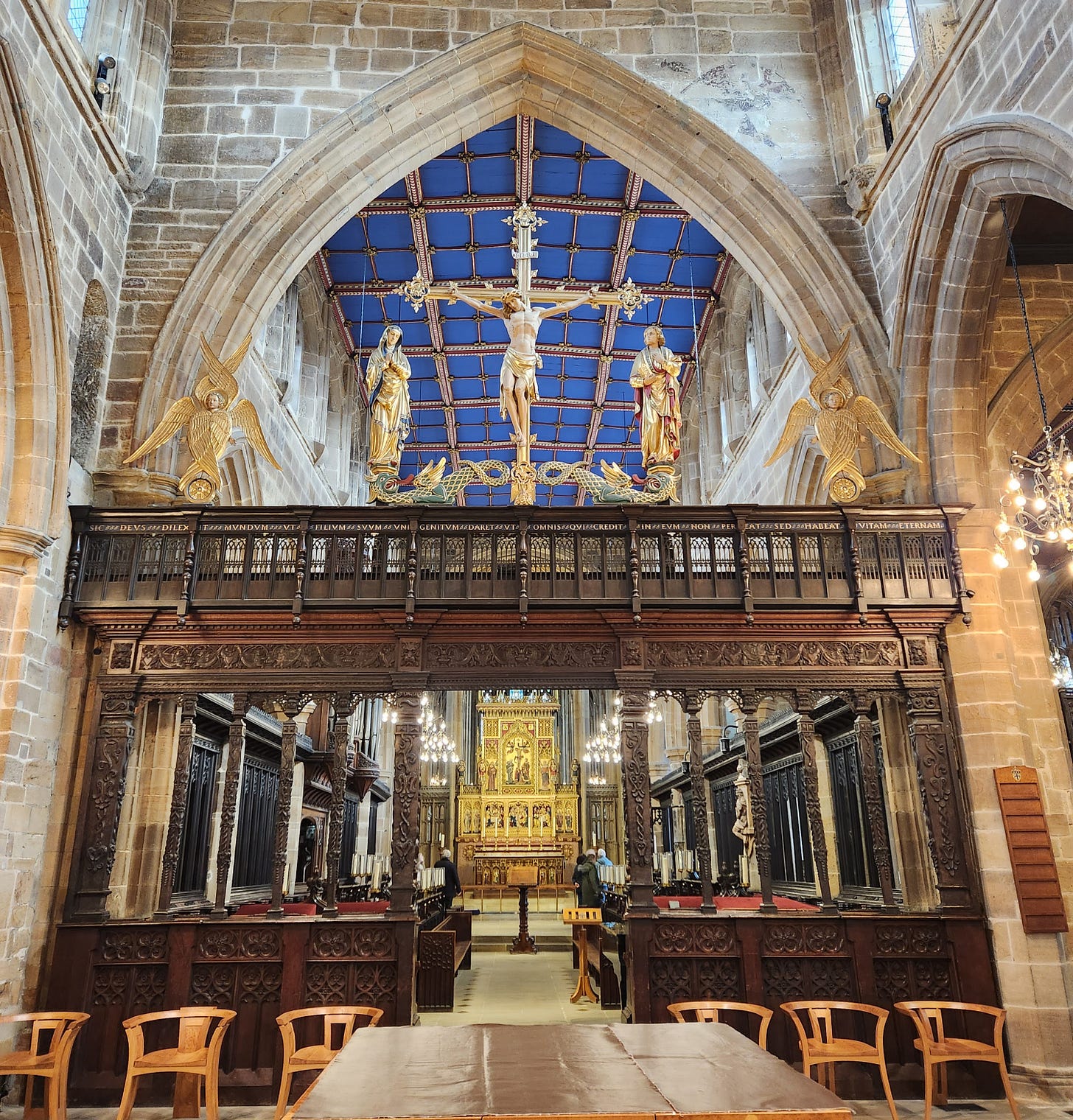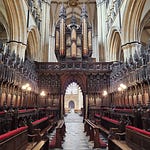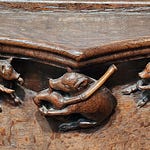The separation of the congregation according to sex is a very ancient arrangement. A rule given in the Apostolical Constitutions runs, “let the doorkeepers stand at the gate of the men and the deaconesses at the gate of the women.” St Cyril, St Augustine of Hippo and other early writers refer to the practice. Socrates asserts that St Helena, the mother of the Emperor Constantine, always behaved submissively in this respect, praying in the women's part with the women. In St John Chrysostom's days, as appears from one of his homilies, a wooden partition divided the men from the women, though he admits that such was not a primitive custom. 1
Eusebius alleges that the practice of dividing the sexes is as old as the time of St Mark; some consider it even an inheritance from Jewish usage. The women's side was commonly the north, the men's the south; but in the east, the women often sat in galleries above the men. In art, the Blessed Virgin is always placed at the right hand of her crucified son and St. John at his left; thus, the figure of the mother on the rood screen is on the north, that of the apostle on the south. Whether this has anything to do with the respective positions of men and women in church, it would be impossible to say, probably, with any certainty, but the coincidence is worth noting. The prayer book of 1549 has an allusion to this custom; in the office for “The supper of the Lord and Holy Communion, commonly called the Mass,” is a rubric which orders that “so many as shall be partakers of the Holy Communion shall tarry still in the choir, or in some convenient place nigh the choir, the men on the one side and the women on the other side.” This direction was observed at the cathedrals of Hereford and Durham, so far as the seating of any of the public within the choir was concerned, until comparatively recent times. The usage as a standing rule of the place has been revived in many churches. Thirty years ago, and probably still, the sexes were always divided in the free seats of Wesleyan Methodist chapels in Cornwall.
The conduct of the congregations of the past would strike a modern worshipper as very strange in at least one particular. It was usual, apparently at the end of the Middle Ages, for men to keep their hats on their heads in church. In 1556, Cardinal Pole had specially to order the “veiling of bonnets” at Hereford, even at the incarnatus in the nicene creed; and at the funeral of Bishop Cox in Ely Cathedral in 1581 the people sat having their bonnets on during a sermon. A sermon preached by the Reverend James Rowlandson at Southampton in 1620 alleges that this was a foreign habit: “How unmannerly,” exclaimed the preacher, “are many that carry themselves with more loneliness in a gentleman's hall (for there they will uncover), than in the house of God! A French fashion indeed, but very ill-favoured, though it be naturalised amongst the most, and grown English even in our greatest congregations, where the apprentice that stands bare-headed all the week long in his master's shop must needs have his hat on in the church.” Archbishop Laud did his utmost to abolish the irreverent custom, but it lingered on in places for fully half a century more. William III had a habit of covering during the sermon, and sometimes even at the prayers. But the usage had then so far died out that the royal example, instead of leading to a revival of it, caused much offence. With the puritans and especially the early quakers this practice was elevated almost into a principle as exhibiting to the full their contempt for all outward forms and ceremonies.
Custom does not seem to have prescribed any laws for the dress of the congregation in England as is the case in some parts of the Continent; as, for example, in Malta, where, howsoever gaily the ladies may array themselves at other times, a studiously grave attire is assumed for church. In the Scilly Isles, however, it was usual at the beginning of this century for girls to wear white only on Christmas Day, and it is a common superstition that one must wear something new, it matters not what, on Easter Day.
Although, as we have seen, the dogs from the hall occasionally had a pew specially set apart from them, such was not the universal practice, and at any rate dogs of meaner ownership had to be excluded. The services of the dog whipper were therefore called into play. In the cathedrals of St David's and Durham this was a recognised officer of the foundation, and we find traces of him elsewhere. A memorandum of 1585 refers to this official at Ecclesfield, where he was known as the Dog Noper. The accounts of East Halton, Lancashire, have an entry of the kind for whipping dogs out of the church. An endowment for a dog whipper for Calverley in Shropshire was made by deed in 1659, and the tenant of certain lands at Christel, Kent pays, or as lately as 1842 paid, ten shillings a year to a man to keep order in church, his original duties being clearly shown by the fact that the land is still called Dog Whipper's Marsh. In the vestry of Baslow Church, Derbyshire, the whip used by the local officer, a short ash stick with a stout lash three feet long, is preserved. And in North Wales are kept instruments once used to capture dogs in the church. They resemble long tongs of iron with short spikes within the extremities, wherewith to get a grip on the unlucky animals. Trysull, Staffordshire, had a pound per annum bequeathed to it in 1725 by John Rudge to pay a man to drive dogs out of the church and to go round during the sermon and wake up all sleepers. In a similar spirit, the sum of five shillings per annum was left to the collegiate church of Wolverhampton by Richard Brooke to secure the services of a man who should keep all the boys quiet during divine service. In the Isle of Man, part of the summoner's duty was to stand at the chancel door at the time of service, to whip and beat all the dogs.
Almost the only links left us now between the corporate life of our towns and the church, which, by means of the ancient guilds, were once so closely knit together, are the official attendances of our civic authorities at church on important occasions. The mayor, escorted by a more or less full muster of the aldermen and councillors is usually present on the Sunday morning after his formal installation, and in the days before the reform of our municipal corporations the procession made a brave show.
Her Majesty's judges generally make a state to progress to church, also on the Assize Sunday, and in some places, notably at Durham, this is accompanied with no little old-fashioned pomp.
As we have seen was the case with the churchyard, so also with the church. There was at one time considerable liberty taken as to conduct therein, but a clear distinction seems to have been made in pre-Reformation days between the chancel and the nave. The former, usually guarded by its screen, was kept rigidly for its high and holy purposes. The latter was at times the common place for the parishioners to meet in, and the liberty thus allowed ran in many cases, according to the tendency of human nature, into licence. Booths were at one time erected in Ely Cathedral, where St Audrey's laces, made of thin silk, were sold.
Nor was the abuse of the house of prayer confined to its use as a place of merchandise. Aubrey, writing in 1686, says it was anciently the custom in Yorkshire in the Christmas holidays to dance in the church after prayers crying or singing “Yole, Yole, Yole.” This looks like a relic of one of those sacred dances once employed in various places, of which very obvious relics yet survive in Spain and in the Spanish-American countries of South America
In 1637, the parishioners of Clungunford, Shropshire, presented a petition to Archbishop Laud, complaining that the parson of the parish declined to allow them an Easter feast, which had become traditional among them. They set forth that the old and poor folk of their scattered parish had been used for many ages to be regaled with bread, cheese and beer, after Evensong on Easter Day, having first communicated at the celebration of the Eucharist that morning; that for some fifty years, in accordance with the wish of the Archbishop of that day, the feast had taken place in the parsonage, but that previously it had been held in the Church. Now, however, it was discontinued altogether. Laud's comment on the petition, still extant in his own writing, was as follows: “I shall not go about to break this custom, so it be done in the parsonage house, in a neighbourly and decent way but I cannot approve of the continuance of it in church; and if I hear it be done so again I will not fail to call the offenders into the High Commissioner's court.” The practice was not confined to that one parish. In the same county in the parish of Berrington, a similar feast was held. A document dated August the 22nd, 1639, and signed by Wright, Bishop of Lichfield, attesting that it had been so accustomed, time out of mind, and that the feast was even yet performed in the church. In this case also, Wright, like Laud, encouraged the continuance of the usage, but forbade its taking place on holy ground. Still worse than this was the presence now and again of actual profanity, as when women were found singing ribald songs in procession within the cathedrals, as Sir Thomas More complains.
Naturally, at the Reformation a good deal of this kind of indecency took place. The more extreme reformers, for whom the English Reformation was by no means sufficiently thorough, delighted in showing their contempt for all that others considered holy. Thus we find Hooper directing, at his visitation of the Diocese of Gloucester in 1552, “that you do move the people committed to your charge not to talk or walk in the time of sermon, communion or common prayers…. that the church wardens do not permit any buying, selling, gaming, outrageous noises, tumult or any other idle occupying of youth in the church, church porch or churchyard during the time of common prayer, sermon or reading of the homily.”
In partial explanation of these secular usages arising in earlier times, it should be pointed out that many of our churches and even some of the cathedrals were not formally consecrated till long after their erection. In 1237, Cardinal Otho, acting as papal legate, found it needful to issue injunctions that all such should be consecrated within two years under pain of interdict. In later times we can find no excuse except the secularity of the people and the carelessness of too many of the clergy thus a public thoroughfare was suffered in several of the cathedrals; such was the case at Canterbury, Worcester, Durham, Norwich, Salisbury, and elsewhere, the market people freely carrying their wares to the Close or to any place on that side of the church through the cathedral and the cloisters. The most notorious of these cases was that of St Paul's, “Paul's Walk” being for many years a well-known public promenade. Complaints were made as early as the time of Edward III and again under Richard III, of the resort of idlers to St. Paul's and of the use of portions of the precincts by craftsmen and traders. Under Henry VIII and Edward VI the state of things got so bad as to call for the passing of an act in the reign of Mary to mend matters. From the terms of the statute it appears that not only were “beer, bread, fish, flesh, fardels of stuff, etc.,” carried constantly through the cathedral but a common passage was even claimed for mules, horses, and cattle generally. And there was no interruption of this traffic even during divine service; “It is a great disorder in the church,” says a presentment of the time of Elizabeth, under whom the old evils, if momentarily checked by this act, had assumed full sway, “that porters, butchers and water-bearers, and who not, be suffered (in special time of service) to carry and recarry whatsoever, no man withstanding them or gainsaying them.”
These most objectionable practices were revived to some extent in the new St. Paul's, as is evident from the fact that another act was passed in the reign of William and Mary against such offences, inflicting a penalty of £20 upon the disorderly frequenters of the Church.
I recently discovered the passage Rev. Tyack is referring to in Homily 73 on Matthew: “Many come in gazing about at the beauty of women; others curious about the blooming youth of boys…. Are you curiously looking after women’s beauty, and do you not shudder at thus doing despite unto the temple of God? Does the church seem to you a brothel, and less honourable than the market place? For in a market place indeed you are afraid and ashamed to appear to be looking after any woman, but in God’s temple, when God himself is discoursing unto you and threatening about these things, you are committing whoredom and adultery at the very time in which you are being told not to do this. And do you not shudder, not stand amazed?…. It were meet indeed that you had within you the walls to part you from the women; but since you are not so minded, our fathers thought it necessary by these boards to wall you off; since I hear from the elders that of old there were not so much as these partitions.”













Share this post